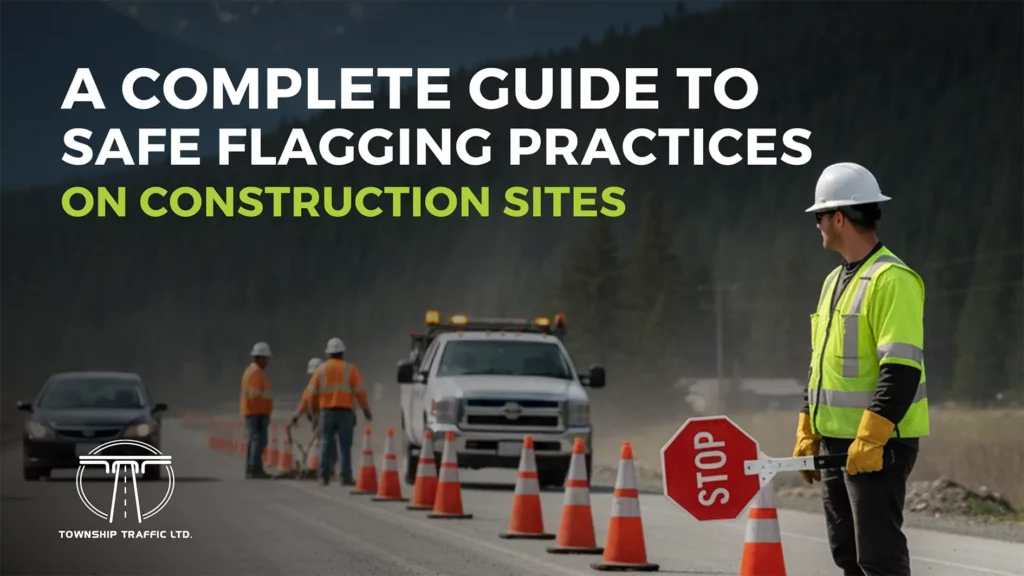Have you ever driven past a construction site in British Columbia and noticed someone calmly holding a stop/slow paddle, directing traffic through what seems like chaos? That person is a flagger, one of the most critical professionals ensuring safety on busy roads and construction zones. From roadwork in Langley to infrastructure projects in Abbotsford, flaggers protect both workers and the public, keeping traffic flowing smoothly while preventing accidents. Their role is vital, and understanding safe flagging practices in BC is essential for any construction or roadwork project.
At Township Traffic Ltd, we know that effective traffic control services go far beyond holding a paddle. It’s about clear communication, situational awareness, and precision, backed by proper training and adherence to WorkSafeBC and Ministry of Transportation standards. Our team of certified flaggers ensures every worksite in the Fraser Valley and Metro Vancouver operates safely and efficiently.
In this complete guide, we’ll cover everything you need to know about flagger training, responsibilities, best practices, and legal compliance, helping you maintain a safe, well-managed construction site from start to finish.
1. What Is Flagging and Why Is It Essential on Construction Sites
Flagging is the practice of directing and controlling traffic safely through or around a construction zone. Flaggers, also called Traffic Control Persons (TCPs), play a crucial role in protecting both workers and the public. They act as the eyes and ears of a worksite, managing the movement of vehicles, pedestrians, and heavy equipment to prevent accidents and ensure a smooth workflow.
The responsibilities of a flagger go far beyond simply holding a stop/slow paddle. Their main objectives include:
- Protecting workers and pedestrians: Ensuring everyone on and near the worksite stays out of harm’s way.
- Preventing traffic collisions: Guiding vehicles safely through potentially confusing or congested areas.
- Minimizing traffic disruption: Maintaining a steady flow of traffic around work zones to reduce delays and frustration for drivers.
- Communicating effectively: Coordinating with other flaggers, construction teams, and drivers to avoid misunderstandings and unsafe situations.
Without properly trained flaggers, construction sites can quickly become dangerous. Confusion or poor communication is one of the leading causes of accidents in work zones. That’s why WorkSafeBC requires all flaggers on public roads to undergo formal training and certification, ensuring they have the skills and knowledge to manage traffic safely.
Flaggers are more than just safety personnel — they are essential guardians of every construction site, helping projects in places like Langley, Abbotsford, and across the Fraser Valley run efficiently and safely.
2. Flagger Training and Certification in British Columbia
In BC, flaggers must complete a recognized Traffic Control Person (TCP) training course, which includes both classroom instruction and practical field assessments.
The training covers:
- Traffic control equipment setup.
- Understanding road layouts and work zone design.
- Communication signals and procedures.
- Personal protective equipment (PPE) requirements.
- Emergency response techniques.
Upon passing the exam, flaggers receive a TCP certificate valid for three years, after which they must undergo recertification.
Companies like Township Traffic Ltd only deploy certified flaggers who meet or exceed provincial safety standards. This commitment ensures every worksite operates under professional supervision — reducing risks and ensuring compliance with WorkSafeBC and Ministry of Transportation and Infrastructure (MOTI) regulations.
3. Essential Equipment for Safe Flagging
Safety begins with proper equipment. Every flagger must be equipped with the right tools to perform effectively and stay visible in all conditions.
Key items include:
- High-visibility apparel: A CSA-approved reflective vest, pants, and arm/leg bands to ensure visibility from 300 meters away.
- Stop/Slow paddle: The primary communication device for controlling vehicle movement.
- Hard hat and safety boots: To protect against falling objects and uneven ground.
- Two-way radios: For constant communication between flaggers and site supervisors.
- Traffic cones and signage: To create clear lane separations and warning zones.
At Township Traffic Ltd, we routinely inspect and maintain all flagging equipment to ensure optimal performance on every job site — whether in Surrey, Burnaby, Langley, or Abbotsford.
4. Safe Flagging Practices Every Site Should Follow
a. Maintain Constant Awareness
Flaggers must stay alert to every vehicle, pedestrian, and piece of equipment in their surroundings. Distracted flagging can lead to serious accidents. Staying focused and avoiding phone use or unnecessary conversations is critical.
b. Establish Clear Communication
Eye contact, consistent hand signals, and proper paddle positioning are key. Flaggers should always communicate with other traffic control team members to anticipate changes and coordinate safely.
c. Proper Positioning
Flaggers should stand in a location visible to approaching drivers but far enough from moving vehicles to avoid danger. Typically, this is about 15–30 meters ahead of the work zone, depending on the posted speed limit.
d. Manage Traffic Flow Smoothly
The goal is not just to stop traffic, but to keep it flowing efficiently and safely. Good flaggers understand driver psychology — using calm gestures and predictable motions to build trust and prevent confusion.
e. Adapt to Weather and Lighting
BC weather can be unpredictable. Fog, rain, or darkness require additional visibility measures such as LED batons, floodlights, and reflective rain gear.
5. Common Hazards and How to Prevent Them
Flagging comes with unique challenges, especially on high-speed roads and busy urban routes. Some common hazards include:
- Impatient or distracted drivers – Prevent by maintaining visibility and clear signage far ahead of the site.
- Slippery or uneven surfaces – Ensure stable footing and proper PPE.
- Blind corners or hills – Place warning signs well in advance of the flagging position.
- Equipment movement – Maintain communication with machinery operators and avoid standing behind vehicles.
By implementing proactive safety plans and ongoing supervision, Township Traffic Ltd helps reduce the likelihood of incidents on BC job sites.
6. Legal and Regulatory Compliance in BC
Every traffic control setup must comply with WorkSafeBC’s Occupational Health and Safety Regulation (Part 18: Traffic Control) and MOTI’s Traffic Management Manual for Work on Roadways.
This includes:
- Approved Traffic Management Plans (TMPs) before starting work.
- Use of certified flaggers only.
- Proper signage and barricade placement.
- Clear detour or lane closure instructions for drivers.
Failing to comply can lead to fines or even worksite shutdowns. By working with Township Traffic Ltd, contractors ensure all legal requirements are met — saving both time and potential liability.
7. The Role of Professional Traffic Management Services
While some small contractors may try to handle traffic control internally, partnering with a professional traffic management company like Township Traffic Ltd offers significant advantages:
- Access to certified, experienced flaggers.
- Complete setup of traffic control devices and signage.
- On-site supervision for compliance and safety assurance.
- 24/7 availability for emergency response or short-notice projects.
Township Traffic Ltd serves clients across Metro Vancouver and the Fraser Valley, including Langley, Abbotsford, Chilliwack, Maple Ridge, Surrey, and Coquitlam, providing end-to-end traffic control and flagging solutions tailored to each site’s needs.
8. Building a Culture of Safety
Ultimately, safe flagging practices depend on creating a culture where everyone values safety first. This includes:
- Regular toolbox talks and safety briefings.
- Encouraging open communication between workers.
- Reporting near-misses or unsafe behavior.
- Providing rest breaks to reduce fatigue.
When flaggers feel supported and respected, they perform better — protecting lives and ensuring projects stay on schedule.
In Conclusion
Flagging is more than just stopping traffic — it’s about keeping people safe, managing risks, and ensuring construction projects run smoothly. In British Columbia, having trained and certified flaggers is essential for every roadwork or construction site.
Township Traffic Ltd provides professional flagging and traffic control services across Langley, Surrey, Abbotsford, and the Fraser Valley. Our certified team ensures work sites are safe, compliant, and efficient, no matter the project size. When you work with us, your safety is our top priority — every site, every shift.
Frequently Asked Questions (FAQ)
- What is flagging in construction?
Flagging is the process of controlling and directing traffic safely through or around a construction site. Flaggers, also called Traffic Control Persons (TCPs), protect workers, pedestrians, and drivers while keeping traffic flowing efficiently.
- Why are safe flagging practices important?
Safe flagging reduces the risk of accidents, prevents injuries, and ensures smooth traffic flow around construction zones. Without trained flaggers, construction sites in BC can become hazardous for both workers and the public.
- What training do flaggers need in BC?
Flaggers must complete a Traffic Control Person (TCP) certification course, which covers traffic control procedures, safety equipment, communication methods, and emergency response. Certification is valid for three years.
- How does Township Traffic Ltd ensure safe flagging?
Township Traffic Ltd deploys fully trained and certified flaggers across Langley, Surrey, Abbotsford, and the Fraser Valley. We follow strict safety protocols, provide proper equipment, and plan traffic control solutions tailored to each project.

